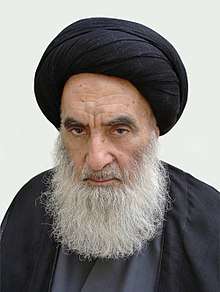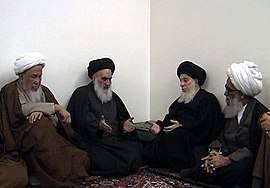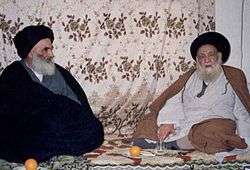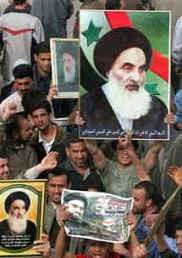Ali al-Sistani
| Grand Ayatollah Sayyid Ali Sistani السيد علي السيستاني | |
|---|---|
 Ayatollah Ali Al-Sistani | |
| Religion | Shia Islam Twelver |
| Other names |
Arabic: علي الحسيني السيستاني Persian: علی حسینی سیستانی |
| Personal | |
| Nationality | Iranian |
| Born |
August 4, 1930 Mashhad, Iran |
| Senior posting | |
| Based in | Najaf, Iraq |
| Title | Ayatollah Sistani |
| Period in office | 1992–present |
| Predecessor | Abu al-Qasim al-Khoei |
| Religious career | |
| Post | Grand Ayatollah |
| Website |
sistani |
Al-Sayyid Ali al-Husseini al-Sistani (Arabic: السيد علي الحسيني السيستاني, born 4 August 1930), commonly known as Ayatollah Sistani in the Western world, is an Iranian Shia marja in Iraq and the head of many of the hawzahs (seminaries) in Najaf.[1]
He is described as the spiritual leader of Iraqi Shia Muslims[2] and one of the most senior clerics in Shia Islam.[3]
Biography
Early life
Sistani was born in 1930 to a family of religious clerics; his father was Muhammad Baqir al-Sistani. Sistani himself claims to have been born in Mashhad, Iran,[4] however there are disputes as to whether or not he was born in Mashhad or in Sistan and then moved to Mashhad as a child due to Iran not issuing birth certificates in its eastern provinces (now known as Region 5) until decades later.
Sistani began his religious education as a child, first in Mashhad in his father's hawzah, and continuing later in Qom. In Qom he studied under Grand Ayatollah Houssein Broujerdi. Later in 1951, Sistani traveled to Iraq to study in Najaf under Grand Ayatollah Abu al-Qasim al-Khoei. Sistani rose to the Usooli clerical rank of 'mujtahid' in 1960.[5] At the unusually young age of thirty-one, Sistani reached the senior level of clerical accomplishment, or ijtihad, which entitled him to pass his own judgments on religious questions.[6]
He has a son called Muhammad Rida al-Sistani.[7]
Grand Ayatollah


When Grand Ayatollah Khoei died in 1992, Sistani ascended to the rank of Grand Ayatollah through traditional peer recognition of his scholarship. His role as successor to Khoei was symbolically cemented when he led funeral prayers for Khoei, He also inherited Khoei's network and following.
Ba'ath Party
During the years of Saddam Hussein's rule of Iraq through the Ba'ath Party, Sistani was untouched during the violent Ba'athist repression and persecution that killed many clerics including Mohammad Mohammad Sadeq al-Sadr in 1999, for which Saddam denied any involvement. His predecessor, Khoei, sat down with Saddam on state TV.[8] After the death of Grand Ayatollah Khoei in 1992, Sistani emerged as the prominent Shia cleric to guide the Shia people under Saddam's rule, although Sistani's mosque was shut down in 1994 and did not reopen until the US-led 2003 invasion of Iraq.
Role in contemporary Iraq
Since the overthrow of the Ba'ath Party, Sistani has played an increasingly prominent role in regional religious and political affairs and he has been called the "most influential" figure in post-invasion Iraq.[9][10]
Shortly after the US invasion began, Sistani issued a fatwa advising Shia clergy to become engaged in politics in order to better guide the Iraqi people toward "clearer decisions," and to fight "media propaganda." As the summer of 2003 approached, Sistani and his followers began to petition the occupying forces for a constitutional convention. Later, Sistani called for a democratic vote of the people for the purpose of forming a transitional government. Observers described the move as being a path leading directly to Shia political dominance over Iraq's government, as Shia Muslims make up approximately 65% of the total Iraqi population. Subsequently, Sistani criticized plans for an Iraqi government for not being democratic enough.
In early August, 2004, Sistani experienced serious health complications related to a previously diagnosed heart condition. He traveled to London to receive medical treatment. It was, reportedly, the first time that Sistani had left Iraq in decades, and may have been due, in part, to growing concerns for his safety from sectarian violence. Though still recovering, Sistani returned later in the month to broker a military truce at the Imam Ali Mosque in Najaf where Muqtada al-Sadr and the Mahdi Army had been cornered by American and Iraqi forces. Sadr, who rose rapidly to prominence through a series of independent military actions beginning in 2004, has since actively challenged Sistani's more progressive influence over Shia in the region.[11]
Sistani's edicts reportedly provided many Iraqi Shia cause for participating in the January 2005 elections—he urged, in a statement on October 1, 2004, that Iraqis recognize the election as an "important matter," additionally, Sistani asked that the elections be "free and fair. . . with the participation of all Iraqis." Soon after, Sistani issued a fatwa alerting Shia women that they were religiously obligated to participate in the election, even if their husbands had forbidden them from voting.[12] In an issued statement Sistani remarked that, "truly, women who go forth to the polling centers on election day are like Zaynab, who went forth to Karbala."[13]
He has consistently urged the Iraqi Shia not to respond in kind to attacks from Sunni Salafists, which have become common in Sunni-dominated regions of Iraq like the area known as the "Triangle of Death," south of Baghdad. Even after the destruction of the Shia Al-Askari Mosque in Samarra in February 2006, his network of clerics and preachers continued to urge calm and told their followers that "it was not their Sunni neighbors who were killing them but foreign Wahhabis."[14] Sistani's call for unity after the bombing of the mosque helped to control a potentially dangerous situation, preventing the country to enter in a bloody sectarian war. Sistani did the same when the same mosque was bombed again in 2007.[15]
An alleged plot to assassinate Sistani was foiled on January 29, 2007, when three Jund al-Samaa gunmen were captured at a hotel near his office. It is believed to have been part of a larger attack against a number of targets in Najaf.[16]
In an online open poll, 2005, Ali al-Sistani was selected as the 30th topmost intellectual person in the world on the list of Top 100 Public Intellectuals by Prospect (UK) and Foreign Policy (US).[17]
On June 13, 2014 Sistani appealed that Iraqis should support the government against the Islamic State of Iraq and the Levant militant group which had taken over Mosul and Tikrit and was threatening Baghdad.[18] Later in June 2014, Sistani revised his statement and issued a fatwa calling for "Citizens to defend the country, its people, the honor of its citizens, and its sacred places," against the Islamic State of Iraq and the Levant terrorist group.[19]
Shia patronage
As the leading Ayatollah in Najaf, Sistani oversees sums amounting to millions of US dollars. Sistani's followers offer him a fixed part of their earnings (tithe), which is used for educational and charitable purposes. Sistani's office has reported that it supports 35,000 students in Qom, 10,000 in Mashhad, and 4,000 in Isfahan.[20] It also oversees a network of representatives (wakil) "who promote his (Sistani's) views in large and small ways in neighborhoods, mosques, bazaars, and seminaries from Kirkuk to Basra."[21]
Additionally, Sistani has a substantial following within Shia communities all over the world and is the current Grand Marja of the Twelver sect of Shia Muslims. In Iran, as a result of the post-invasion opening of the Iraqi cities of Najaf and Karbala to Iranians, many Iranians are said to return from pilgrimage in Iraq as supporters of Sistani.[22]
Criticism and controversy

Al Jazeera
In May 2007, hundreds of Shias demonstrated publicly in Basra and Najaf to protest comments made by television presenter and journalist Ahmed Mansour during a Qatari broadcast of Al Jazeera television programming. While presenting Bela Hodod (a.k.a. Without Borders), Mansour voiced skepticism of Sistani's leadership credentials while directing questions about the Iranian-born cleric to his guest, Shia cleric Jawad al-Khalsi. Mansour also suggested that Sistani was not aware of contemporary problems in Iraq or of prevailing post-war conditions, and he alleged that Sistani's edicts were, largely, written and disseminated by aides. At another point, Mansour asked Khalsi whether the United States was using Iraqi politicians, and also Sistani, to promote western interests in Iraq.[23]
Saudi cleric
In January 2010, during a Jumu'ah khutba (Friday sermon), Saudi cleric Mohamad al-Arefe vehemently criticized Sistani by referring to him as an "atheist" and by describing his behavior as "debauched".[24] The remarks prompted protest by his followers in Iraq, Qom and Lebanon. Iraqi Prime Minister Nouri al-Maliki rebuked the Saudi religious authorities.[25] Lebanon-based Islamist militant organization Hezbollah also condemned the attack on Sistani, calling the speech "inauspicious," while praising Sistani as one of Shia Islam's "most prominent religious references."[26]
Nobel Peace Prize nomination
On 4 March 2014, the Daily Telegraph commentator Colin Freeman published an article[27] naming Ali al-Sistani as the most appropriate Nobel Peace Prize candidate. He also reported that he had been nominated earlier in 2006, by a group of Iraqi Christians.
On 8 March 2014, The Tehran Times[28] reported that a group of members of Iraqi parliament announced that they intended to nominate Ali al-Sistani for the 2014 Nobel Peace Prize.
Thomas L. Friedman, former bureau chief of The New York Times in Beirut and Jerusalem (1982–88), proposed Ayatollah Sistani for the prize in 2005 in a column published in the Times on 20 March 2005.[29]
Guardianship of Islamic Jurists (wilayat al Faqih)
Like his predecessor Abu al-Qasim al-Khoei, Sistani has not wholly embraced the post-Age-of-Occultation theory known as the Guardianship of the Islamic Jurists, which was espoused and supported by the late Iranian Grand Ayatollah Ruhollah Khomeini and which is currently extant and enforced by the Iranian government through its own constitution and by its supreme leader and highest religious authority Ayatollah Ali Khamenei. Sistani's scholarship regarding guardianship resembles Khoei's scholarship, but differs in several respects. Additionally, the primary difference between Sistani's interpretation and the interpretation of Grand Ayatollahs Khomeini and Khamenei is reportedly in the range of power that a Grand Ayatollah has in ruling the Islamic community. Sistani has publicly stated and maintained that his interpretation of doctrine is one that grants more power to the Ayatollahs than Khoei, but less than either Khoemeini or Khamenei:
Question: What is Grand Ayatollah Sistani's opinion about Velayat-e Faqih?
Answer: Every jurisprudent (Faqih) has wilayah (guardianship) over non-litigious affairs. As for general affairs to which social order is linked, and enforcement of doctrine, this depends on certain conditions, one of which is popularity of the Faqih among the majority of momeneen (believers).[30]
On the specific question of obedience to a supreme leader, Sistani has said that any pronouncement given by a supreme leader "supersedes all, (including those given by other Maraji') unless the pronouncements are proven to be wrong or the pronouncements are proven to be against what is in the Qur'an or in Religious Tradition."[31]
Additionally, instead of advocating for rule by Islamic clerics or for fundamentalist legal views, i.e. "the Quran as constitution," Sistani is said to favor a more relaxed perspective related to the provision of values and guidelines for social order (nizam al-mujama) as being the recognized, primary role of Islam.[32]
Also, according to Sadegh Zibakalam, professor of political science at Tehran University, Sistani has consistently avoided supporting strict interpretation of the theory, especially of absolute guardianship, nor has he explicitly offered any substantive affirmation of the theory as a whole (including limited guardianship); thereby creating "a major lacuna" in the "grand ideological scenario" of the Islamic Republic of Iran.[33]
According to scholar Vali Nasr, despite Sistani's disagreements with Iran's ruling clerics, he has "never tried to promote a rivalry" between his religious center of Najaf and the Iranian center in Qom, and has never made any comments about the confrontations between reformists and conservatives in Qom or between clerics in Lebanon,[34] a reflection, Nasr believes, of Sistani's reluctance to become involved in politics.
Works
Works translated to English
- Current Legal Issues
- A Code of Practice For Muslims in the West
- Hajj Rituals
- Islamic Laws
- Jurisprudence Made Easy
- Contemporary Legal Rulings in Shia Law
Non-English
His office states that thirty-two other works exist, but have not been translated into English.[35]
Internet
By working with Shia computer programmers and other specialists, Sistani sponsored the establishment of The Aalulbayt (a.s.) Global Information Center, an international web-resource, and he has since been called "the electronic grand ayatollah par excellence."[36]
Cyber attacks
On September 18, 2008, hackers attacked hundreds of Shia websites. The attacks reportedly were the work of group-xp, a Muslim faction based in the United Arab Emirates which is linked to Salafi and Wahhabi, strict forms of Islam. They attacked an estimated three hundred Shia internet websites including The Aalulbayt (a.s.) Global Information Center. It was later dubbed the "largest Wahhabi hacker attack" in recent years.[37]
After the attack, visitors to the site were greeted by a red attack banner bearing the slogan "group-xp" paired with a message in Arabic denouncing Shia beliefs and officials. Hackers also replaced a video of Sistani with one of comedian Bill Maher mocking Sistani.[38]
However, the attack led to the retaliatory hacking of more than nine hundred Wahhabi and Salafi websites.[39] One such successful attack was documented on video and uploaded to YouTube on October 3, 2008. The hacker, a Shia from the United Arab Emirates using the handle "ShiaZone," was shown logging into email accounts of suspected members of group-xp. The hacked email accounts reportedly yielded group-xp's contact information, information that was subsequently posted on Shia websites.[40]
Public appearances
Oddly, Sistani has notoriously avoided public appearances, despite his widespread fame and not shying away from attention. In practice, Sistani never delivers public sermons or speeches, and only releases official statements through 'official representatives'. This is alleged by some to be due to Sistani's screechy voice, which would be unappealing and damaging to Sistani's public image. The statements are later transcribed and posted on Sistani's official webpage, with the Grand Ayatollah's official stamp, indicating the authenticity of the remarks. Though Sistani has appeared in a few short videos, he does not say anything in these videos and is usually motionless. The only known public recording of Sistani's voice is a short, Persian-language, lecture by Sistani to students.[41] Another video depicts Sistani in the back of room conversing with a fellow cleric, again in Persian, and faintly captures sparse bits of Sistani's vocalizations.[42]
Journalist Ahmed Mansour has suggested that Sistani's Fatwas (edicts) were largely written and disseminated by his aides.[23] Currently, Sheikh Abdul-Mahdi Al-Karbalai is Sistani's foremost representative and gives speeches in Sistani's stead.[43] Abdul-Mahdi Al-Karbalai is noted for having announced Sistani's famous Fatwa (edict) obligating Iraqis to vote, and with the rise of terrorism, to join the military to oppose ISIS.[19]
See also
References
- ↑ Nasr, Vali, The Shia Revival, Norton, (2006), p.171
- ↑ Cockburn, Andrew M. (16 November 2003). "U.S. Ignores This Ayatollah in Iraq at Its Own Peril". Retrieved 24 February 2017 – via LA Times.
- ↑ Watling, Jack. "The Shia Militias of Iraq". The Atlantic. Retrieved 24 February 2017.
- ↑ "Biography - The Official Website of the Office of His Eminence Al-Sayyid Ali Al-Husseini Al-Sistani". www.sistani.org. Retrieved 15 May 2017.
- ↑ Sami Moubayed (February 10, 2005). "Coming to terms with Sistani". Asia Times. Archived from the original on 10 August 2007. Retrieved 2007-08-21.
- ↑ "When Grand Ayatullah Sistani Speaks, Millions Obey: Says Time". al-khoei.org. 30 April 2005. Archived from the original on June 28, 2007. Retrieved 2007-08-21.
- ↑ C. N. N. Library. "Grand Ayatollah Ali al-Sistani Fast Facts". CNN. Retrieved 11 August 2017.
- ↑ Daily Times editorial, dated 15th Feb, 2013. "Grand Ayatollah Syed Abul Qassem al-Khoei - II Tammy Swofford"
- ↑ Gethin Chamberlain and Aqeel Hussein (2006-09-04). "I no longer have power to save Iraq from civil war, warns Shia leader". The Telegraph. London. Retrieved 2007-08-21.
- ↑ "Shiite Cleric Seen as Iraq's Most Influential Leader". Fox News. AP. November 27, 2003. Retrieved August 21, 2007.
a frail, 70-something Shiite Muslim (search) cleric with a heart condition—has emerged in post-Saddam Hussein Iraq as the land's most influential figure, something US planners may not have counted on.
- ↑ Rowan Scarborough "Al-Sadr's Killing Fields", Washington Times, September 1, 2004, http://archive.frontpagemag.com/readArticle.aspx?ARTID=11563
- ↑ Nordland, Rod (February 9, 2005). "The Cities Were Not Bathed in Blood". Newsweek.
- ↑ al-Rahim, Ahmed H. (2005). "The Sistani Factor". Journal of Democracy. 16 (3): 50–53 [p. 51]. doi:10.1353/jod.2005.0038.
- ↑ Nasr, Vali, The Shia Revival, Norton, (2006), p.178
- ↑ chronicle.fanack.com. "The Reclusive Grand Ayatollah Sistani Remains Highly Influential in Iraq". fanack.com. Retrieved 27 July 2015.
- ↑ ZEYAD KASIM (06-03-2007). "Messianic Shia Cult Emerges in Southern Iraq". www.iraqslogger.com. Archived from the original on July 7, 2007. Retrieved August 21, 2007. Check date values in:
|date=(help) - ↑ "Intellectuals". Prospect. 2009-10-14. Archived from the original on 2009-09-30. Retrieved 2012-08-15.
- ↑ "Could Isis take Iraq's capital?". New Statesman. Retrieved 19 June 2014.
- 1 2 Al Khatteeb, Luay (10 July 2014). "What Do You Know About Sistani's Fatwa?". Huffington Post. Retrieved 8 July 2015.
- ↑ Martin Kramer (April 4, 2003). "The Ayatollah Who Spared Najaf". Archived from the original on July 8, 2011. Retrieved 2007-08-21.
- ↑ Nasr, Vali, The Shia Revival, Norton, (2006), p.177
- ↑ Nasr, Vali, The Shia Revival, Norton, (2006), p. 221
- 1 2 "Iraqi Shia protest against Al-Jazeera's "insults" against top cleric". International Herald Tribune. AP. May 4, 2007. Archived from the original on December 5, 2008. Retrieved 2007-08-21.
- ↑ "No Operation". PressTV. Archived from the original on 2012-10-07. Retrieved 2012-08-15.
- ↑ "موقع قناة المنار- لبنان". Al-Manar. Retrieved June 1, 2016.
- ↑ "Hezbollah Denounces Offense against Shiites, Sayyed Sistani". Al Jazeera. Archived from the original on January 14, 2010. Retrieved June 1, 2016.
- ↑ Colin Freeman (4 March 2014). /forget-obama-and-the-eu-the-man-who-should-really-have-the-nobel-peace-prize-is-an-obscure-iraqi-cleric/ "Forget Obama and the EU. The man who should really have the Nobel Peace Prize is an Obscure Iraqi Cleric" Check
|url=value (help). Telegraph. Retrieved 24 February 2017. - ↑ Iraqi MPs launch move to nominate Ayatollah Sistani for Nobel Peace Prize Archived 2014-03-14 at the Wayback Machine.
- ↑ "A Nobel for Sistani". The New York Times. March 20, 2005.
- ↑ Q & A » Governance of Jurist (1)
- ↑ Ayatollah Watch quoting statement on his website on 9 August 2009
- ↑ Nasr, Vali, The Shia Revival, Norton, 2006, p. 173
- ↑ Sadegh Zibakalam (2 March 2010). "Iran's top priority in Iraq is anti-Americanism". Daily Star.
- ↑ Nasr, Vali, The Shia Revival, Norton, 2006, p. 172
- ↑ Works of Sayyid Al al-Sistani Archived 2008-03-13 at the Wayback Machine.
- ↑ Pepe Escobar (August 31, 2005). "Sistani. Qom: In the wired heart of Shi'ism". Asian Times. Retrieved 21 August 2007.
- ↑ "الأخبار - استمرار اختراق مواقع إلكترونية للسيستاني ومؤسسات شيعية عربي". Al Jazeera. 2008-09-24. Retrieved 2012-08-15.
- ↑ "IRAQ: The ayatollah gets hacked". Los Angeles Times. September 20, 2008. Archived from the original on 22 September 2008. Retrieved 20 September 2008.
- ↑ "شبكة راصد الإخبارية". Rasid.com. Archived from the original on 2012-03-18. Retrieved 2012-08-15.
- ↑ "اختراق عناوين بريد GroupXP الوهابية التي تحرشت بمواقع الشيعة". YouTube. Retrieved 2012-08-15.
- ↑ "صوت السيد علي السيستاني" on YouTube
- ↑ "السيستاني يتكلم الفارسية صوت وصوره ومن فمهم ندينم" on YouTube
- ↑ "Iraqi cleric Sheikh Abdul Mahdi Karbalai warns of 'threat to peace'". [BBCs]. Retrieved 2015-01-09.
External links
| Wikimedia Commons has media related to Ali Sistani. |
| Wikiquote has quotations related to: Ali al-Sistani |